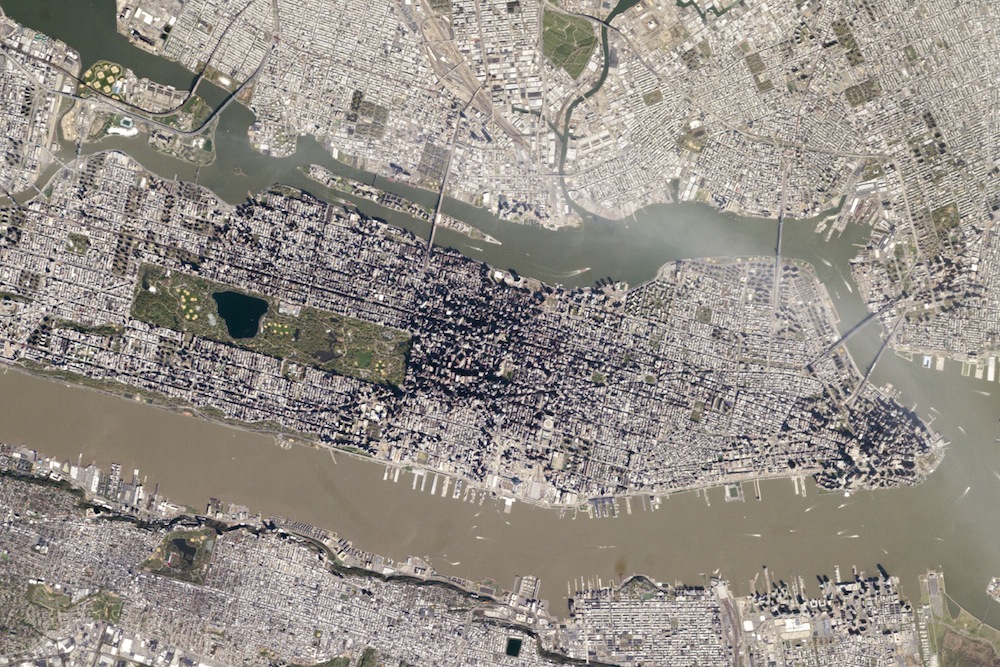'Big Apple' Seen From Space (Photo)

The gridded streets, wharves and skyscrapers of Manhattan look like the work of ants in a new picture taken from far above.
An astronaut aboard the International Space Station snapped this photograph of New York City from about 220 miles (354 kilometers) up on May 5. The East River runs along the top of the photograph, and the Hudson River along the bottom. On the New Jersey side of the Hudson, a dark greenish line runs parallel to the river. This is the Palisades, a steep escarpment between 300 and 450 feet (91 to 137 meters) tall.
In the East River, between Manhattan and Queens, sits the slender Roosevelt Island, with the Ed Koch Queensboro Bridge running over it. Farther toward the tip of Manhattan, the Williamsburg Bridge, Manhattan Bridge and Brooklyn Bridge are visible crossing over the East River. [Earth from Above: 101 Stunning Images from Orbit]
Humans and nature
This image was taken during the early afternoon, according to NASA's Earth Observatory, which released the image today (June 9). Nevertheless, the shadows of some of the city's tallest buildings can be seen, particularly in the Financial District toward the tip of the island, and in Midtown. Central Park appears as an orderly green rectangle, its 18-acre lake visible in blue. The bright dots scattered across the park are sports fields, according to Earth Observatory. Rectangular wharves line the banks of Manhattan, projecting into the Hudson River.
The steel-and-glass canyons of Manhattan align with the natural world a few times a year to create a phenomenon astronomer Neil DeGrasse Tyson has dubbed "Manhattanhenge." Four times a year, the sun sets directly west of the island's avenues, creating a golden glow that permeates the city. Two Manhattanhenge dates have already passed this year (May 29 and May 30), but hopeful skywatchers can look for the next occurrences on July 11 and July 12.
Manhattan's future
Get the world’s most fascinating discoveries delivered straight to your inbox.
As engineered as Manhattan is, it is still vulnerable. In 2012, Hurricane Sandy highlighted the dangers of flooding in the densely packed borough. The storm brought the largest recorded storm surge in history to New York City, with the high-water level at the southern tip of Manhattan reaching 13.88 feet (4.2 m).
As the globe warms and sea levels rise, such surges could become standard. One 2012 study published in the journal Nature Climate Change estimated that 100-year floods could hit Manhattan every three to 20 years by the end of the century. These floods that are now expected about once a century bring a surge of 5.3 feet (1.61 m) of water to The Battery, on Manhattan's southern tip.
Editor's Note: If you have an amazing nature or general science photo you'd like to share for a possible story or image gallery, please contact managing editor Jeanna Bryner at LSphotos@livescience.com.
Follow Stephanie Pappas on Twitter and Google+. Follow us @livescience, Facebook& Google+. Original article on Live Science.

Stephanie Pappas is a contributing writer for Live Science, covering topics ranging from geoscience to archaeology to the human brain and behavior. She was previously a senior writer for Live Science but is now a freelancer based in Denver, Colorado, and regularly contributes to Scientific American and The Monitor, the monthly magazine of the American Psychological Association. Stephanie received a bachelor's degree in psychology from the University of South Carolina and a graduate certificate in science communication from the University of California, Santa Cruz.


